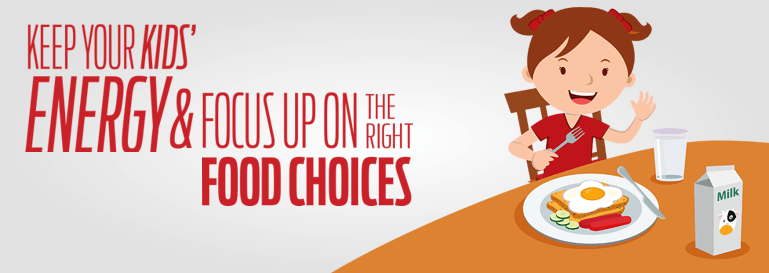Do you struggle as a parent to get your kids to stay focused ALL day through school, and after? Could it be what they are eating, or perhaps what they are not eating? Nutrition is important for all of us, but especially in a growing child’s body and brain. They need everything they can get for their growing and changing bodies, and to keep up with the demands of school and after-school activities. Let’s support them as best as we can, to help them achieve their goals and stay healthy throughout the school year by providing the right foods, and eliminating the wrong foods.
Start the day off right by providing a nutritious breakfast. Feeding them “whole grain cereal” with fruit? Not a good choice. And here’s why. The combination of cereal and fruit is bad for blood sugar control. These are both carbohydrates and sugars. They will create a spike in glucose, providing initial energy and alertness. But come 2 hours later, the glucose drops, and your child is now sleepy in class at 9 or 10 am. The energy has burned off. The nutrient quality of most processed cereals is also poor, despite the fact they have been fortified with synthetic nutrients. Most of them have corn syrup added, and some have food coloring. (And most of them are really not “Whole” grains, they are grains processed into flour with nutrients removed).
So what do you feed them at breakfast? Protein and healthy fats are the names of the game! They will maintain their energy for a longer period of time. The protein and fats also feed the brain. Our brain is made of mostly fat, so healthy fats at breakfast are absolutely key to mental alertness, brain function, and development, and also help curb sugar cravings later on.
Here are my favorite picks for breakfast ideas:
1- Eggs!!
Eggs are only 78 calories per egg, 6 gms of protein, and contain Vitamin D, A, B12, and B6. Scrambled, omelets full of vegetables, or poached. Or plan ahead and have several hard-boiled eggs on hand ready to go. My personal favorite is egg muffins! Make these ahead of time, and store them in the fridge for up to 3 days. Make them like you will make an omelet. Directions: Sauté up spinach, kale, zucchini, bell peppers, mushrooms, asparagus, or any vegetable, in olive oil. Add sea salt. In a bowl whip up 5 eggs to make 6 muffins or 10 for a dozen. Add herbs or seasonings of your choice. (I like Herbs du Provence). Mix in the sautéed vegetables. You can sprinkle a little cheese of your choice for flavor. Spoon into muffin tins greased with coconut oil or organic butter, and bake at 400 for 20 minutes. Enjoy!
2- Protein Smoothie or Smoothie
Use a high-quality protein powder (I recommend a vegan one, avoid whey and soy). Make sure the smoothie contains more vegetables than fruit, otherwise it will be too much sugar! Add in superfoods like chia seeds, hemp seeds, wheat grass (especially if getting them to eat their veggies is a challenge), and ground flax seeds. Be sure to add 2 tsp coconut oil for their healthy fat dose.
3- Steel Cut Oats
These are lower glycemic index scales compared to regular cereal or oatmeal. So the carbohydrate is slowly burned off, avoiding a sugar crash. Add in coconut oil, superfoods, nuts, seeds, cinnamon, dried cranberries, or other fruit for extra nutrition and flavor. Save time and soak the night before in a jar.
4- Sprouted GrainToast
with either avocado and tomato or nut butter if not allergic. Almond butter has a healthier type of fat compared to peanut butter. And sprouted grain bread has 4 grams of protein per slice! And it is a true whole grain, unlike most “whole wheat or whole grain” versions of bread.
5- Homemade Pancakes or Waffles
Made with coconut, almond, or oat flour, and mashed bananas or apple sauce. Use healthy oil such as flax, walnut, or coconut oil in place of Canola or corn oil. Top with organic maple syrup, or crushed fruit. Be sure to serve it with protein!
OK, so we have breakfast covered. What about lunch? Are they eating food provided by the school? It depends on what the school is providing for lunches. Some lunch programs have healthier options than others. Start by knowing exactly what the quality of the food served is. Eat lunch with your child and taste it for yourself. If the broccoli is overdone, has had all the nutrients cooked out of it, and is bland, tasteless, and your child won’t eat it, then pack a lunch. If they are eating French fries daily, then pack a lunch.
6- Bento-Box style snack lunch
Forget about the pre-packaged lunch kits with processed cheese and meat. Make your colorful box up. Throw in a few pieces of high-quality nitrate-free rolled lunch meat. Cube up some cheese, or put a cheese slice within the meat. Please do not use processed cheese slices! Throw in some veggies such as sliced cucumber, cherry tomatoes, baby carrots, broccoli, or a pickle. For the dip, skip the Ranch. Put in a small dish of guacamole, homemade Tzatziki made with Greek yogurt or flavored hummus. I believe in starting children off young by expanding their palate, so don’t be afraid of “adult” foods!
7- Greek yogurt with fresh or frozen fruit
Skip the individual yogurts. Buy large plain Greek yogurt, put it in a smaller dish, and add in your fresh fruit, a dash of local raw honey or agave syrup, sprinkle some nuts (if allowed) or coconut and pumpkin seeds on top, maybe a little low sugar granola. Make a small dish for their “dessert” or snack.
8- Soup to go
Send them off with a Thermos full of a healthy, preferably homemade, soup or chili. You can hide so many veggies into soups, chilis, and stews! Place some non-GMO non-trans fats crackers in a bag, and they are set. If buying soup, buy in the box, not can, unless the can states the lining is BPA-free. (BPA is found in the lining of some cans and plastic containers/bottles and is a known hormone disruptor).
9- Tuna or Chicken salad
in a bowl, or as a sandwich on sprouted grain bread. So my favorite trick is to use a ripe avocado in place of mayonnaise. Avocados are full of healthy fats and nutrients. Add in chopped celery, cilantro, green onion, or any finely chopped veggie you want to hide in there. Add in olive oil and lemon or lime juice to help it blend better add a dash of sea salt and pepper. (But please do not do tuna more than once a week, due to mercury levels).
This is a fun one. Using a sprouted grain wrap, spread hummus on the wrap, and fill it up with meat or protein of choice, kale, romaine, or spinach for greens, cucumber, tomato, sprouts, and avocado. For a treat, buy healthy versions of crackers or chips, and put them in a small snack bag. Skip the mini chip bags.
Snacking ideas
Put grapes in a bag or dish; sliced apples; small homemade fruit cup rather than canned fruit full of syrup; bag or dish of raw nuts if allowed; make a homemade protein or energy balls using nut butter, honey, seeds, cocoa, oats, coconut, etc. Slice veggies and hummus or Tzatziki dip. Make up your trail mix and send it off in a bag or dish.
10- Drinks:
Water; coconut or almond milk, cow’s milk if no issues with allergies; a veggie-fruit juice blend cut 50% with water; chilled flavored herbal tea like peach or mango tea. Avoid soda or other pre-packaged drinks that are full of sugar and food coloring. And especially avoid artificially sweetened drinks.
- Avoid processed foods.
Read the labels! If there is a long list of additives, food colorings, and preservatives, don’t buy them. (Those little fish crackers? Read the label first). If there are ingredients you do not have in your kitchen that you could make yourself, don’t buy them. Keep their food real, whole food. Preservatives and food colorings can affect the gut health of anyone, and lend to an array of health issues, including mood and mental focus. Skip the fake food, don’t change it. For children with ADD/ADHD, this is especially important, along with a gluten-free/grain-free diet.
Hope these tips can help your child have a successful and healthy school year, and help them keep their focus. Watch how foods affect your child, their digestion, mood, behavior, energy, allergies, and sleep. They may have hidden sensitivities, and symptoms can be subtle. Seeing a functional medicine health coach or practitioner may help. Stay tuned for other tips on optimizing your child’s focus in school.


